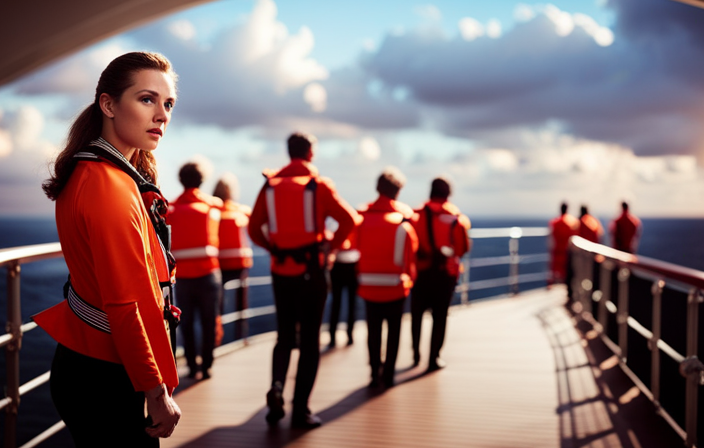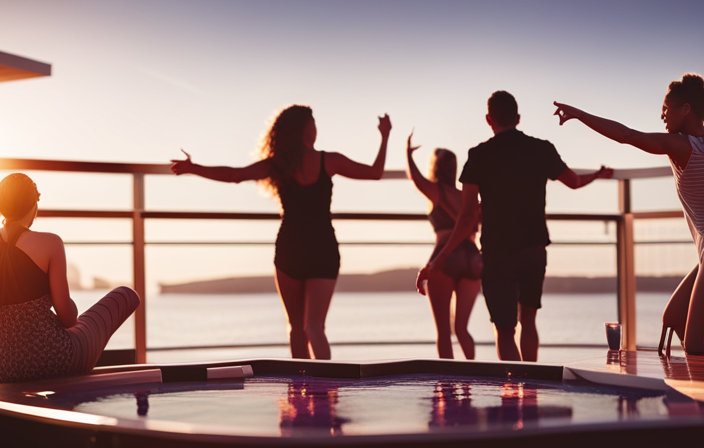Have you ever been curious about what goes on during a cruise ship muster? Allow me to shed some light on it for you. A muster is a crucial safety exercise that occurs at the start of each cruise voyage. During this period, all passengers assemble in specific areas to get acquainted with emergency protocols and understand how to remain secure should unexpected situations arise.
During muster, the crew members provide essential information about evacuation routes, life jackets, and other safety measures. They ensure that everyone understands their role in an emergency situation and knows where to go for assistance. Muster drills are crucial because they prepare us for potential emergencies and help maintain a safe environment onboard.
In this article, we will explore the purpose of muster on a cruise, delve into the different safety measures implemented on cruise ships, discuss what to expect during a muster drill, and highlight the importance of compliance with these drills.
So buckle up as we embark on this informative journey through the world of muster on a cruise!
Key Takeaways
- Muster stations are important for passenger safety during emergencies and chaotic situations.
- Compliance with the safety briefing and attending the muster drill is mandatory for all passengers.
- Skipping the muster drill can result in penalties, including denied access to certain areas or removal from the cruise.
- Cooperation and following instructions during the drill contribute to a smooth muster experience and overall passenger safety.
The Purpose of Muster on a Cruise
Muster drills are an essential part of cruise ship safety protocols. The purpose of these drills is to familiarize passengers with emergency procedures and ensure they know how to respond in case of an actual emergency.
By participating in muster drills, passengers gain valuable knowledge about life jacket usage, evacuation routes, and assembly stations. This information becomes crucial in the event of an emergency situation such as a fire or shipwreck.
Additionally, muster drills help crew members identify any potential issues or challenges that may arise during an evacuation. Therefore, by actively engaging in these drills, passengers contribute to the overall safety and security of everyone onboard the ship.
Understanding the importance and benefits of participating in muster drills sets the foundation for implementing effective safety measures on cruise ships without compromising anyone’s well-being.
Safety Measures on Cruise Ships
Imagine sailing the high seas, surrounded by a shield of protective measures ensuring your safety and well-being on board. Cruise ships prioritize passenger safety through comprehensive emergency response procedures and evacuation plans. These measures swiftly and efficiently handle potential emergencies during your voyage.
Cruise ship evacuation is meticulously planned, guaranteeing safe and orderly disembarkation in emergencies. The crew undergoes rigorous training to execute these protocols effectively, ensuring everyone knows what to do.
In addition, cruise ships have state-of-the-art technology to monitor systems, detect hazards, and mitigate risks promptly. Fire detection systems, lifeboats, life rafts, and life jackets are among the safety measures in place.
Muster drills are crucial, familiarizing passengers with emergency procedures, evacuation routes, and assembly points. This knowledge equips passengers to react swiftly in actual emergencies.
Transitioning to the next section about the importance of muster drills, passengers must understand how these drills contribute to their overall safety on a cruise ship.
Importance of Muster Drills
Get ready to learn why participating in these essential safety drills is crucial for your peace of mind and personal well-being on a cruise ship. Muster drills are of utmost importance when it comes to ensuring the safety of passengers and crew members.
These drills allow everyone on board to familiarize themselves with the emergency procedures, such as locating life jackets, finding designated muster stations, and understanding evacuation protocols. By actively participating in these drills, you not only gain knowledge about how to keep yourself safe in case of an emergency but also contribute to creating a safer environment for all passengers on the ship.
It’s important to remember that emergencies can happen at any time, so being prepared and knowing what to do can make a significant difference.
Now let’s delve into what you can expect during a muster drill without further ado.
What to Expect During a Muster Drill
When participating in a muster drill on a ship, you can expect to experience a sense of security and reassurance. This drill is informative and potentially life-saving, as it teaches you important safety procedures for emergencies at sea. The crew members will guide you through the process, providing clear instructions and demonstrating how to properly wear a life jacket. They will also inform you about emergency signals and evacuation routes specific to your assigned muster station.
During the drill, you will have the opportunity to familiarize yourself with the ship’s layout and understand what actions to take in case of an emergency. By actively participating and paying attention, you will gain confidence in knowing that the crew is well-prepared to handle any situation that may arise.
So, let’s now delve into the specifics of muster stations and emergency procedures without delay.
Muster Stations and Emergency Procedures
Discover the peace of mind that comes with knowing your assigned muster station and understanding the emergency procedures that will keep you safe in any situation.
In the unlikely event of an emergency evacuation, it is crucial to know where to go and what to do. Each passenger is assigned a specific muster station, which is typically indicated on your key card or through announcements.
Once at your muster station, you will receive important instructions from the crew members on board. It is essential to pay attention and follow their guidance carefully.
During this time, crew members will provide information about emergency exits, lifeboat locations, and other safety procedures. As passengers, we have a responsibility to familiarize ourselves with these procedures and be prepared for any unexpected situations that may arise while on board. This ensures a safe and orderly evacuation if needed.
Speaking of safety equipment…
Life Jackets and Emergency Equipment
Put on your life jacket and familiarize yourself with the emergency equipment available on board. Life jackets are essential safety devices that can save lives in case of an emergency at sea. They are located in your cabin or at designated muster stations throughout the ship.
Make sure you know where your nearest emergency exit is, as well as the evacuation procedures in case of a ship-wide emergency. Familiarize yourself with the location and operation of fire extinguishers, alarms, and other emergency equipment.
Being prepared and knowledgeable about these resources will help ensure your safety during any unexpected situations on a cruise ship.
In the next section, we will discuss the crucial role crew members play during muster without writing ‘step’.
Role of Crew Members During Muster
The crew members on board play a vital role in ensuring the safety of all passengers during emergency drills. They are trained extensively to handle various situations that may arise during a cruise. Here are some key ways in which crew members contribute to the safety of everyone on board:
- Conducting informative safety briefings and demonstrations.
- Assisting passengers with locating and donning life jackets.
- Directing passengers to designated muster stations.
- Ensuring that all passengers are accounted for during drill exercises.
- Coordinating with other crew members to effectively respond to emergencies.
The role of crew members cannot be overstated when it comes to maintaining the utmost safety measures on a cruise ship. They are well-prepared and equipped to handle any situation that may occur, putting the well-being of passengers as their top priority.
Moving forward, let’s explore how muster procedures differ for different types of emergencies.
Muster for Different Types of Emergencies
Imagine being on a cruise ship, suddenly hearing alarms blaring and feeling a slight panic in the air. Crew members swiftly guide passengers towards safety during different types of emergencies. Muster for these emergencies is crucial to ensure the well-being of everyone on board.
The type of emergency determines the specific procedures that need to be followed. For example, in case of a fire, passengers are instructed to gather at designated muster stations. There, they receive further instructions and are accounted for. In the event of a medical emergency or severe weather conditions, passengers may be directed to their cabins or other safe areas.
These emergency procedures are carefully designed and practiced to minimize risks and maintain order during chaotic situations at sea. Understanding and following these protocols can greatly enhance passenger safety on cruises.
Transitioning into the subsequent section about ‘compliance and consequences of skipping muster’, it is important to highlight the significance of adhering to these emergency procedures.
Compliance and Consequences of Skipping Muster
Make sure you don’t skip the crucial safety briefing on board, or else you may face serious consequences. Compliance with the muster drill is not optional – it’s mandatory for all passengers. Skipping it can result in penalties such as being denied access to certain areas of the ship or even being removed from the cruise altogether. The consequences are in place to ensure everyone’s safety and to maintain order during emergencies.
To give you an idea of what could happen if you fail to comply, here are a few examples:
- You may be required to attend a makeup session later, which can disrupt your planned activities.
- Your onboard account privileges could be temporarily suspended until you attend muster.
- In extreme cases, repeated non-compliance can lead to legal action.
It is essential that every passenger understands the importance of attending muster and follows through accordingly. With that said, let’s move on to some tips for a smooth and safe muster experience.
Tips for a Smooth and Safe Muster Experience
To have a smooth and safe muster experience, follow these helpful tips:
- Arrive at the muster station early to avoid any last-minute rush.
- Familiarize yourself with the location of your designated station beforehand, as it may differ from your cabin’s location.
Listen attentively to the instructions provided by the crew members during the muster drill, as they are crucial for your safety in case of an emergency.
- Remember to bring along your life jacket and ensure that it fits properly.
- Be respectful and cooperative throughout the drill, as it is not only for your own safety but also for the safety of everyone on board.
Lastly, familiarize yourself with all onboard safety measures and guidelines to ensure a smooth muster experience throughout your cruise journey.
Frequently Asked Questions
Are muster drills mandatory for all passengers on a cruise ship?
Yes, muster drills are mandatory for all passengers on a cruise ship. They are important for passenger safety as they familiarize everyone with emergency procedures. Failure to attend can result in penalties or even being denied access to certain areas of the ship.
Is there a specific time and location for muster drills on a cruise ship?
Yes, there is a specific timing and location for muster drills on a cruise ship. These drills are usually held before the ship sets sail and passengers must gather at their assigned muster station, or in some cases, alternate locations if necessary.
What should passengers do if they are unable to attend the scheduled muster drill?
If I am unable to attend the scheduled muster drill, there are alternative options available. It is important to follow safety protocols, so I should inform the crew and participate in a make-up drill if necessary.
Can passengers bring their own life jackets on a cruise ship?
Passengers cannot bring their own life jackets on a cruise ship as the ship provides them. However, passengers can bring pets and inform the cruise line of any dietary restrictions for accommodations to be made.
How often are muster drills conducted during a cruise?
Muster drills, which ensure passenger safety, are conducted regularly on cruises. The frequency of these drills varies but is typically done within 24 hours of embarkation. These safety measures are crucial for the well-being of everyone on board.
Conclusion
In conclusion, participating in muster drills on a cruise ship is not only mandatory but also crucial for the safety and well-being of all passengers. According to statistics from the Cruise Lines International Association (CLIA), 99% of passengers who have experienced an emergency situation on a cruise ship reported feeling more confident and prepared because they had attended a muster drill.
These drills ensure that everyone knows what to do in case of an emergency, making the entire cruising experience safer for everyone on board.
So remember, don’t skip muster – it could save your life.










